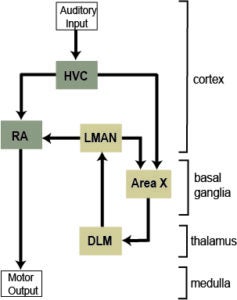The goal of our lab is to investigate whether specific subcircuits within cortico-basal ganglia pathways mediate distinct aspects of goal-directed skill learning. Vocal learning in songbirds is highly developmentally regulated and provides a powerful experimental model for exploring brain-behavior relationships. We test the role of specific neural circuits in evaluating self-generated actions against a goal behavior as juveniles are refining their behavioral output. Juvenile songbirds learn a behavioral goal (memorized vocal sounds from a tutor) and produce variable behavioral output (babbling) during a process of trial-and-error learning in which actions that match the learned goal sounds are gradually strengthened.
 The schematic at left shows the simplest possible version of functional circuits that mediate vocal learning and behavior.
The schematic at left shows the simplest possible version of functional circuits that mediate vocal learning and behavior.
The projection from HVC (High Vocal Center) to RA (vocal motor cortex) controls behavioral output in real time in adult birds that have already learned their song pattern.
A separate group of projection neurons in HVC projects to the basal ganglia: Area X is a specific region dedicated to song learning and behavior that contains both striatal and pallidal neurons. LMAN is another cortical nucleus that projects into the basal ganglia. This pathway forms a loop from cortex to basal ganglia to thalamus and back to cortex:
LMAN→Area X→DLM →LMAN
The function of the LMAN loop is highly dynamic during development; lesions of LMAN in young juveniles are highly disruptive to behavior and learning, whereas lesions in older juveniles and adults have no disruptive effect on behavior. For the original report of this study, see Bottjer et al. 1984 (a classic paper).
We record neural activity in awake behaving juvenile songbirds during development as they are actively engaged in learning. One strategy is to record from distinct subgroups of neurons identified by their selective tuning to either a neural representation of the goal (tutor song) or to feedback of self-generated behavior as juveniles begin to refine their output. We posit that these two neural signals of goal-directed learning give rise to distinct subcircuits as part of the mechanism underlying action-outcome evaluations. A major prediction is that cortical neurons that are selectively tuned to the memorized goal representation provide a filter for identifying behavior that matches the goal, and convey this information to the basal ganglia. These data will provide an important test of how goal-similar actions are identified and strengthened in cortical circuits and their downstream targets.
Learn more about the current research projects conducted by our Lab Members.
For a full list of publications from the Bottjer lab, click here.